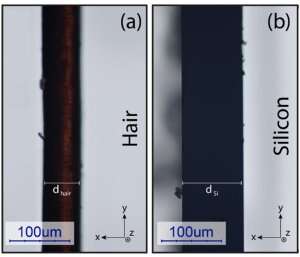Phys.org October 18, 2021
Recently, a new type of wavefront shaping was introduced where the extinction is manipulated instead of the scattered intensity. The underlying idea is that upon changing the phases or the amplitudes of incident beams, the total extinction will change due to interference described by the cross terms between different incident beams. Researchers in the Netherlands have experimentally demonstrated the mutual extinction and transparency effects in scattering media a human hair and a silicon bar. They sent two light beams with a variable mutual angle on the sample. Depending on the relative phase of the incident beams, they observed either nearly zero extinction, mutual transparency, or almost twice the single-beam extinction, mutual extinction, in agreement with theory. They used an analytical approximation for the scattering amplitude, starting from a completely opaque object. The work could have applications in various fields such as non-line-of-sight communications, microscopy, and biomedical imaging…read more. Open Access TECHNICAL ARTICLE

Credit: The transparency of a human hair (left) and a bar of silicon (right) can be tuned, in this way it is also possible to determine the exact thickness. Credit: University of Twente